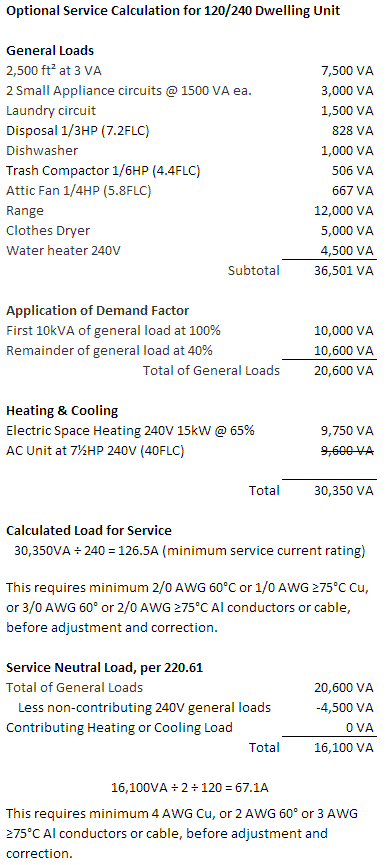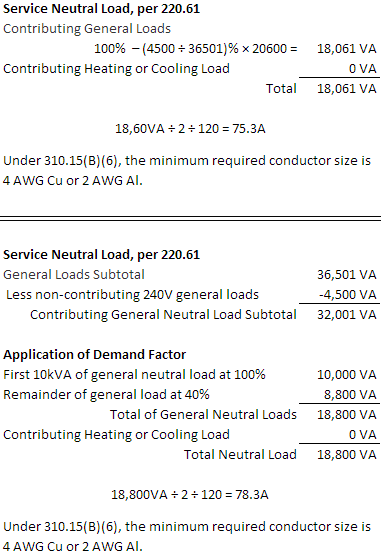Smart $ here is the load for a single family dwelling.
2,500 sq. ft.
2 small appliance circuits
1 laundry circuit
12 kw range 120/240
5 kw dryer 120/240
1 kw dishwasher 115 volts
1 disposal 1/3 h.p. 115 volts
1 waterheater 240 volts
1 attic fan 1/4 h.p 115 volts
1 trash compactor 1/6 h.p 115 volts
15 kw electric heat 240 volts
7-1/2 h.p. a.c. unit 240 volts
Using the optional method what size ungrounded conductors would I need and using the optional method what is the minimum size ungrounded conductors and what is the minimum size grounded conductors needed.
I see that you are now steering away from the code in that the style manual specifically tells you what a "article" is as far as the code is written. I find it even more interesting that you don't even do calculation's but you are certain you are correct. I am not trying to be critical. I have taught electrical code classes for 13 years and constantly here journeyman and master electricians making statements that they have no bases for or they say something that they can't explain. I will be the first to admit that I learn new things everyday and that I am no where close to knowing everything about the code. I do make mistakes but I am confident I am correct here. Here from you soon with your calculation.
2,500 sq. ft.
2 small appliance circuits
1 laundry circuit
12 kw range 120/240
5 kw dryer 120/240
1 kw dishwasher 115 volts
1 disposal 1/3 h.p. 115 volts
1 waterheater 240 volts
1 attic fan 1/4 h.p 115 volts
1 trash compactor 1/6 h.p 115 volts
15 kw electric heat 240 volts
7-1/2 h.p. a.c. unit 240 volts
Using the optional method what size ungrounded conductors would I need and using the optional method what is the minimum size ungrounded conductors and what is the minimum size grounded conductors needed.
I see that you are now steering away from the code in that the style manual specifically tells you what a "article" is as far as the code is written. I find it even more interesting that you don't even do calculation's but you are certain you are correct. I am not trying to be critical. I have taught electrical code classes for 13 years and constantly here journeyman and master electricians making statements that they have no bases for or they say something that they can't explain. I will be the first to admit that I learn new things everyday and that I am no where close to knowing everything about the code. I do make mistakes but I am confident I am correct here. Here from you soon with your calculation.


